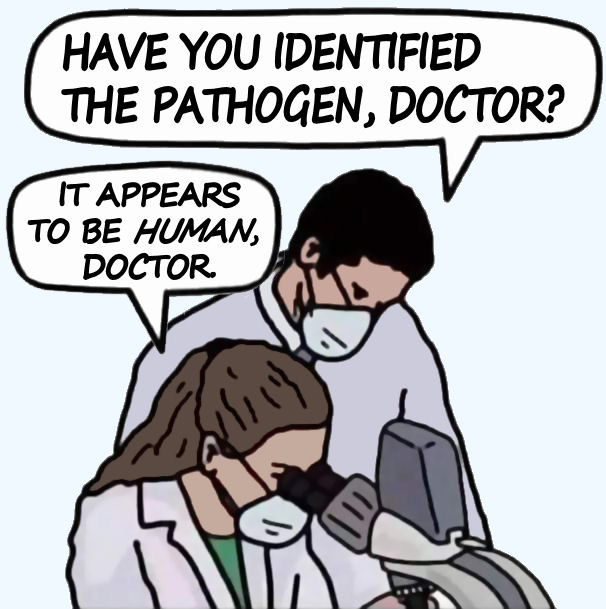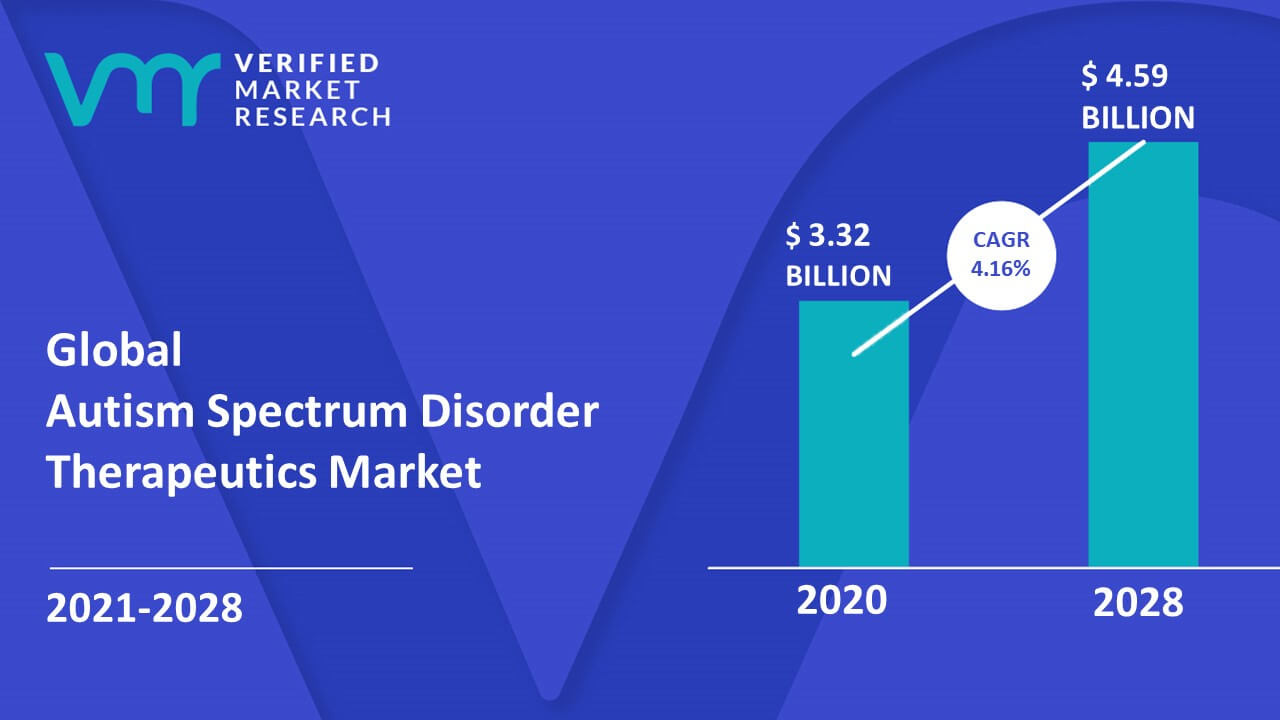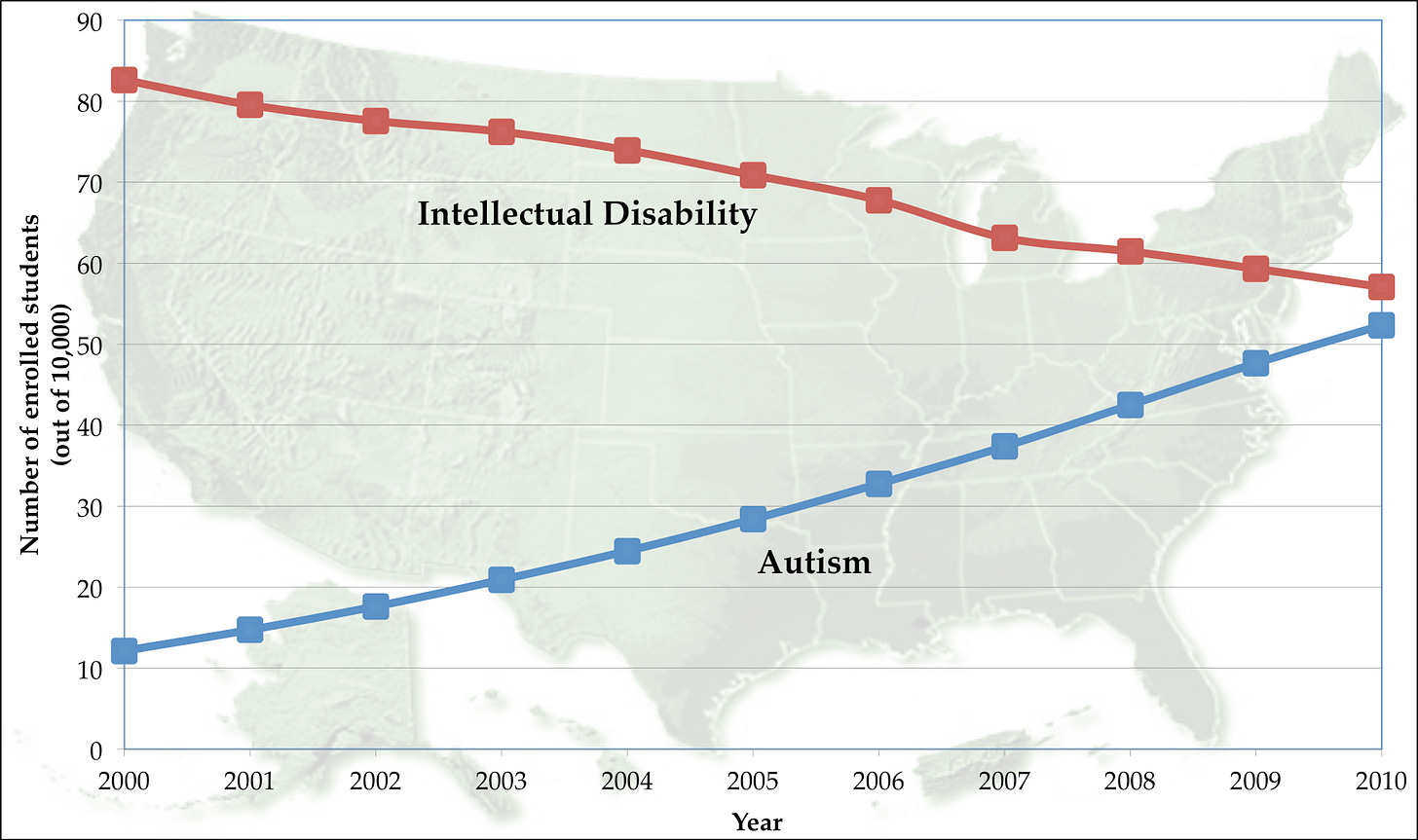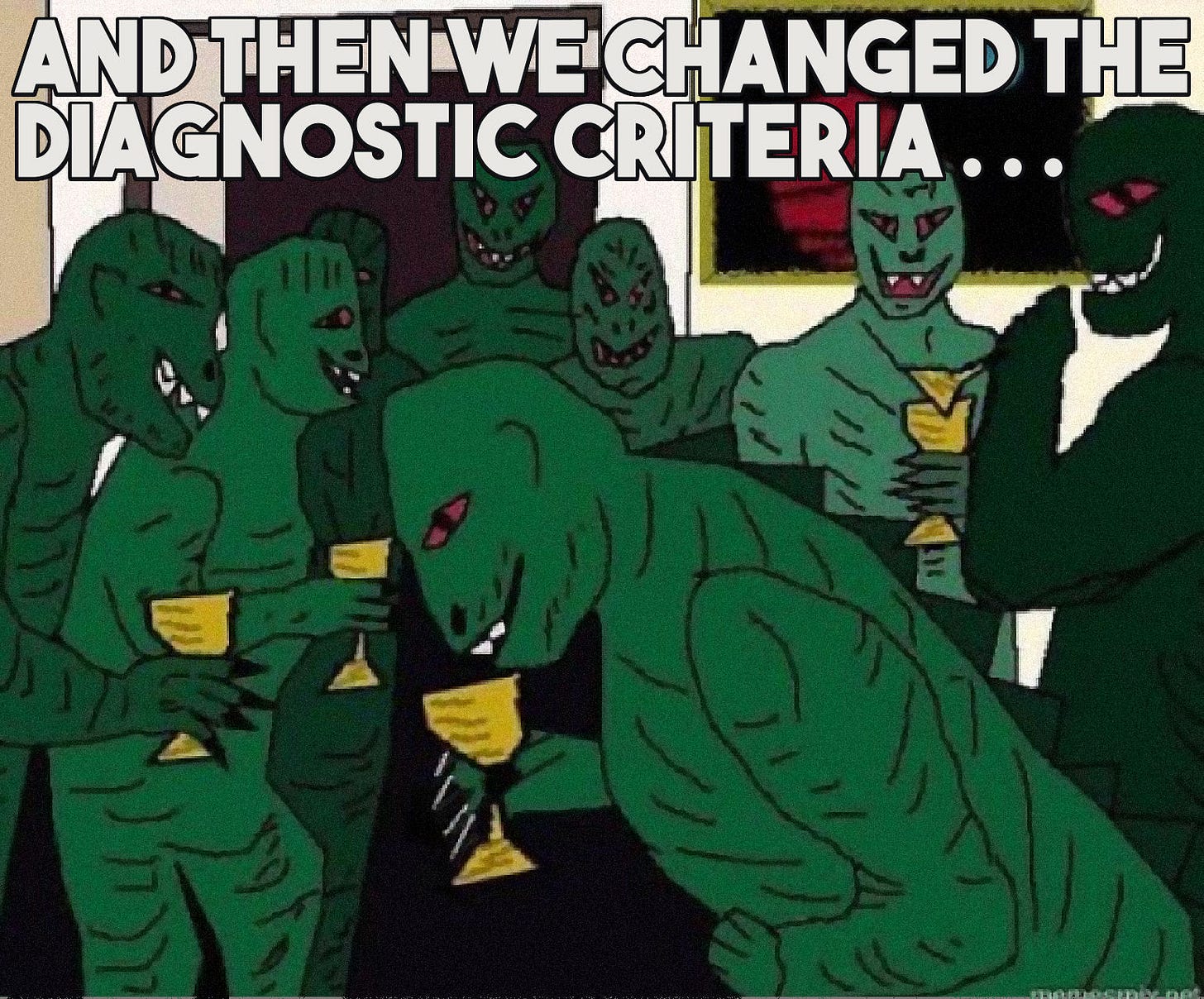Big Phautism / Fauxtism?
Like climate change, policies around autism are being coordinated by international ‘stakeholders’ including the WHO, UN and other NGO's
Note: The USA is the global leader in Big Phautism. Though it is spreading rapidly elsewhere, for this examination I look chiefly at US statistics and organisations. —Mrs. H.
You Don’t Know Me
"The key finding being that society does not understand autism."
—Chris Edwards, et al, ‘Most people have no idea what autism is’: Unpacking autism disclosure using social media analysis, 2024
How can it be that with all the concern about the surging crisis of the supposed autism epidemic, all the celebrity shine, talkshow, podcast hyper-ventilatory tongue-waggery, the science-y reportage and overgrowth of autism-awareness campaigning, that, it turns out, people are more confused than ever about autistic people?
A recent survey of self-reporting autistics on social media found that ‘ASD is poorly understood . . . across society’:
‘Most people have no idea what autism is’ (T430) with autistic users sharing that their identity was commonly questioned with people ‘thinking that I’m lying or faking (autism) for attention’ (R275). Users shared that because of the way autism is viewed in society, autistic people ‘HAVE to consider potential implications of telling people’ (R323). Autistic users expressed that they were hesitant to disclose, with one user noting that ‘the few times I have told others I’ve been bombarded with “cures”. Use this oil, do this detox, talk to this natural doctor, buy these crystals, it’s always overwhelming’ (R741). The widespread stigma associated with autism in society was described by one user as ‘HUGE’ and in their own experiences, they had been called, ‘Rain Man, a curse, a savage’ and even ‘compared to CANCER’ (T1126) after their disclosure.
Indeed.
I’ve been told that I’m ‘not autistic’. And I’ve been told that detoxing might ‘cure’ me. Those incidents happened online on forums and social media. In real life, my one-time boss’s mother, a school teacher I’d known for several years —like attending family dinners known, took a special ed training course in ‘Autism’, after which how she related to me changed dramatically:
Other users described the frustration of infantilization, how people ‘suddenly change and start treating me as if I’m stupid or talking to me like a child’ (R103) PDF
Yes, exactly.
And me not a spring chicken, even then.
I did say that if she wanted to know something about autism, she could just ask me. Here I am, right here! AMA!
And she never did, of course. It still perplexes me. I mean, why wouldn’t she ask?
But actually, no one ever does. Oh! Except for Kate at Here Come the Meat Bastards, she did.
Our findings provide further evidence of the stigmatized social status of autistic people (Botha & Frost, 2020) and are consistent with previous research where autistic people have reported experiencing stigma (Botha et al., 2020; Shtayermman, 2009) and are perceived negatively, even in brief interactions, by non-autistic people (Sasson et al., 2017).
I guess my boss’s mother felt secure that she’d been trained in autism by the experts and my input might confuse her? Or maybe she was imagining an alternative diagnosis for me? Like sociopathy?
At any rate, dinner invitations dwindled and dried up after that.
Shaking the Money Tree
“I said then [2001] that autism expands with the number of people making a living from this neurological condition —researchers, statisticians, doctors, teachers, journalists, TV and film-makers, novelists, poets, alternative-medicine charlatans, administrators, staff of charities and private-healthcare providers.”
—Michael Baron, co-founder of the National Autistic Society, 2005
And this is what is generally misunderstood or ignored in all the expressed concern about the supposed epidemic —that each alarmist assertion amplifies the opportunities to profit.
A quick search yields a plethora of market research firms selling reports (thus profiting from) the impressive growth of the autism ‘Therapeutics Market’ —with enticing projections of future growth:
‘Therapeutics’, btw, now includes ‘behavioral health’, biotech, brain chip technology, gene therapies, personalised medicine, AI, and new pharmaceuticals.
The global Autism Spectrum Disorder Therapeutics Market has been experiencing substantial growth in recent years. According to market research reports, the market was valued at approximately $3.2 billion in 2020 and is projected to reach $5.4 billion by 2026, growing at a compound annual growth rate (CAGR) of 7.8% during the forecast period.
This impressive growth is driven by several factors, including increasing awareness of ASD, rising prevalence rates, advancements in diagnostic techniques, and a growing pipeline of innovative therapeutic approaches.
Emphasis mine.
Who are we talking about here? Oh. ‘Established pharmaceutical giants and innovative biotech startups.‘
Of course it is:
The ASD therapeutics market is characterized by a mix of established pharmaceutical giants and innovative biotech startups, each contributing to the advancement of treatment options. Major pharmaceutical companies such as Johnson & Johnson, Roche, and Otsuka Holdings have made significant investments in ASD research and development, leveraging their extensive resources and expertise to bring new therapies to market.
Emerging biotech firms are also playing a crucial role in driving innovation in the field. Companies like Yamo Pharmaceuticals, Axial Therapeutics, and Cognoa are at the forefront of developing novel approaches to ASD treatment, focusing on areas such as gut-brain axis modulation, digital diagnostics, and personalized medicine.
Antipsychotics like risperidone and aripiprazole are FDA-approved for treating irritability and aggression in children with ASD. Antidepressants, particularly selective serotonin reuptake inhibitors (SSRIs), are often prescribed off-label to address anxiety and repetitive behaviors. Stimulants, such as methylphenidate, are used to manage attention deficit and hyperactivity symptoms that frequently co-occur with ASD.
Occupational and speech therapies continue to be essential components of comprehensive ASD management, helping individuals develop crucial life skills and improve communication abilities. These therapies are often tailored to the specific needs of each individual, reflecting the heterogeneous nature of ASD.
The National Institutes for Health in the US has been funding pharmaceutical research into the billions, in case there was any doubt about Big Pharma’s stake:
The major players covered in the autism drug market report are Bristol-Myers Squibb Company, ALLERGAN, AbbVie Inc, Johnson & Johnson Private Limited, Takeda Pharmaceutical Company Limited, Merck & Co., Inc, GlaxoSmithKline plc, F. Hoffmann-La Roche Ltd, Eli Lilly and Company, Abbott, Pfizer Inc, Novartis AG, Saniona, Intra-Cellular Therapies, Inc, Curemark, LLC, Coronis Neurosciences Ltd., Otsuka Holdings Co., Ltd, Sun Pharmaceutical Industries Ltd, Teva Pharmaceutical Industries Ltd and Medtronic among other domestic and global players.
That’s ^^^ from a market report that costs $15000 USD for the full package. Very comprehensive indeed. It helpfully lists multiple routes to profit in the drugs market:
By Type: Asperger Syndrome, Pervasive Developmental Disorder, Autistic Disorder
By Mechanism of Action: Antipsychotics, Anticonvulsants, Antidepressants, Stimulants, Others
By Drugs Type: Risperidone, Fluoxetine, Clomipramine, Methylphenidate, Phenytoin, Others
By Therapy Type: Behavioral Therapy, Occupational Therapy, Physical Therapy, Speech Therapy, Others
By Route of Administration: Oral, Intravenous, Others
By Distribution Channel: Online Pharmacy, Direct Tenders
By End-Users: Hospitals, Homecare, Specialty Clinics, Others
The autism market has grown to such a degree that the US Congress passed legislation in 2014 specifically to authorise a new governmental agency to manage all the intersecting federal, state and NGO programs:
Inter-agency Autism Coordinating Committee
Though, Congressional interest in raising ‘autism awareness’ dates back to at least 1999 and the introduction of the National Autism Registry Act, a bill that was meant to establish a ‘national program of autism registries’.
That was shortly after Andrew Wakefield’s press conference where he announced a connection between autism and the MMR vaccine —but I suspect that it had more to do with Phone Phreaks, coders, hackers and savantism.
The Inter-agency Autism Coordinating Committee hosts meetings where international delegates discuss 'how their efforts are rooted in increasing [global] awareness and understanding':
“IACC meetings are pivotal moments for collaboration and progress in understanding and addressing the needs of people with autism around the world,” says Dr. Andy Shih, Ph.D. chief science officer at Autism Speaks. “These meetings provide a platform for us to come together, share insights and discuss strategies for advancing research, policy and services and supports for autistic people and their families. Link
The World Health Organization (WHO) attends to promote its’ ‘public health approach to autism’ and its’ concerns about what it calls ‘health inequities’. In 2024, its’ public health initiatives included a joint WHO/UNICEF/Autism Speaks global report on developmental disabilities, a joint WHO/Autism Speaks caregiver training program, and a joint WHO/UNICEF/Autism Speaks program for ‘psychosocial well-being’:
The UNICEF and WHO Joint Programme on Mental Health and Psychosocial Well-being and Development of Children and Adolescents aims to strengthen the capacity of countries to implement evidence-informed and human-rights based multisectoral strategies to deliver opportunities, support and services for children, adolescents and their caregivers. Link
It’s a nightmarish amalgam of Social Emotional Learning (SEL), UNESCO’s early education brainwashing project and the autism equivalent of the Intergovernmental Panel on Climate Change (IPCC), which can only mean one thing. Just like with the ‘War on Drugs’, there’s gonna be more.
[S]ervice provisions may differ considerably between individuals diagnosed with ASD versus ID . . . This has motivated many parents to seek out an additional ASD diagnosis in order to secure additional services and has further muddled the question of when and for whom a comorbid ASD diagnosis is appropriate.
—Audrey Thurm et al, State of the Field: Differentiating Intellectual Disability From Autism Spectrum Disorder, Frontiers in Psychiatry, 30 July 2019
There is now a separate 600+ page Diagnostic Manual that is just for diagnosing mental disorders in people with ‘intellectual disabilities’. It’s meant to accompany the revised DSM-5-TR, 2022, which lists 237 different mental disorders, up from the mere 106 in the first DSM in 1952.
I, cynical as I am, was still shocked to see the extent of the thing and how entrenched it has become in the State apparatus.
I doubt that this is the outcome envisioned by all those well-meaning people, critical of Big Pharma, who’ve expressed concern for autistic children.
As it is, a gullible, credulous, trusting population has been manipulated into birthing a juggernaut that is aimed directly at children:
Autism Interventionism
What you have now is a foundation laid for profit-extraction with financial incentives for stakeholders to drum up business by finding more and more autistic “bodies” (as Broderick would call them) for which to prescribe more services. That gets done through fear-mongering media campaigns, “awareness” initiatives, pushes for “early intervention” and public admonitions to “know the signs of autism.” The widespread fear/awareness serves to justify what would otherwise be considered excessive and invasive “treatments” for any human being. This is a capital investment opportunity which makes autistic people the commodity. Autism “intervention” is a multi-billion dollar industry. The AIC creates both the demand and supply for services. The identities/interests/opinions of actual autistic people are completely left out of the equation.
—The Blog Lady, from a review of The Autism Industrial Complex: How Branding, Marketing, and Capital Investment Turned Autism into Big Business by Alicia A. Broderick, 2022
All the hypity-hype might have been a sign to be a bit more questioning, no?
Yes.
In my next post I will continue looking at the Big Phautism/Fauxtism Industrial Complex and the role of the hugely influential lobby group/ NGO Autism Speaks and its’ habitual misrepresentation of autism.













OK, so what shall we call the phenomenon that occurs in children who regress into pathological/neurodiverse behaviour following an MMR vaccine? I’m getting the vibe you don’t equate this to autism, or am I wrong here? Personally I absolutely think there should be more emphasis on identifying causes/cures and way less on awareness and I struggle to understand those who wouldn’t agree. Unless it’s people/institutions with a cover-up agenda.
Along with the drive to "cure" and "treat" autism, I have seen a drive to simply medicalize behavior in children, in general. The IEP (individualized education plan) in the US is something that many parents consider a life saver, as it gives specific educational tools/interventions to kids with distinct learning needs. It is also something of a label, as a friend of mine found out, when she unsuccessfully tried to get her boy with an IEP into a Friends school (she believed it was a red flag to them.) I've read that in Finland they give the equivalent of IEPs to all students, temporarily, when needed - this seems to me a better way to go about it. And also makes me suspect that here (and I'm sure in other countries as well) it is completely intentional that children are labeled, so they can then be sold therapeutic products, tools and interventions. These are all Markets - even the children labeled "gifted" are a market.
Which begs the question, Michelle: if we're so smart, why aren't we making any money off of this?!!! Can't we sell some kind of electronic hat, or something? A scented candle?